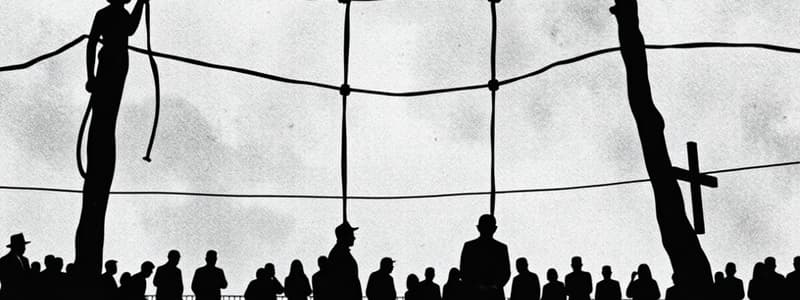Podcast
Questions and Answers
What phenomenon is associated with individuals awaiting execution?
What phenomenon is associated with individuals awaiting execution?
The Death Row Phenomenon.
What is one of the significant costs of capital punishment mentioned in the text?
What is one of the significant costs of capital punishment mentioned in the text?
The greater cost compared to life imprisonment.
Name one argument mentioned that was historically used to support capital punishment.
Name one argument mentioned that was historically used to support capital punishment.
The prevention of lynchings.
How does the text suggest that the debates on capital punishment have changed over time?
How does the text suggest that the debates on capital punishment have changed over time?
What was a common characteristic of the arguments for capital punishment a century ago?
What was a common characteristic of the arguments for capital punishment a century ago?
What demographic was primarily targeted in lynchings mentioned in the text?
What demographic was primarily targeted in lynchings mentioned in the text?
What effect did public discourse have on capital punishment policies in the early twentieth century?
What effect did public discourse have on capital punishment policies in the early twentieth century?
What purpose do the authors intend to achieve by discussing early twentieth-century debates on the death penalty?
What purpose do the authors intend to achieve by discussing early twentieth-century debates on the death penalty?
What was a primary motivation for lynching during the Reconstruction Era?
What was a primary motivation for lynching during the Reconstruction Era?
How many recorded lynchings occurred between 1882 and 1944?
How many recorded lynchings occurred between 1882 and 1944?
In what time period was lynching at its most intense in American history?
In what time period was lynching at its most intense in American history?
What did some high-level elected officials in the South endorse regarding lynching?
What did some high-level elected officials in the South endorse regarding lynching?
Which group was predominantly targeted by lynchings in the South?
Which group was predominantly targeted by lynchings in the South?
How did the number of lynchings compare to legal executions in the 1890s?
How did the number of lynchings compare to legal executions in the 1890s?
Why was the fear of black rapists central to the practice of lynching?
Why was the fear of black rapists central to the practice of lynching?
What was the societal impact of lynching on the black community during the Reconstruction Era?
What was the societal impact of lynching on the black community during the Reconstruction Era?
Flashcards are hidden until you start studying
Study Notes
Lynching and the Death Penalty
- Lynching was a common practice in the United States, particularly targeting Black men in the South.
- This practice continued well past Reconstruction, claiming the lives of over 4,700 people between 1882 and 1944.
- The most common motivation for lynching was the suspicion of a Black man murdering a white person.
- Rape of a white woman by a Black man was the most emotionally potent excuse for lynching.
- Lynching was so prevalent that during the period from 1889 to 1893, more people were lynched than legally executed nationwide.
- The death penalty was seen as a way to combat lynching, by providing a legal alternative to extrajudicial executions.
Studying That Suits You
Use AI to generate personalized quizzes and flashcards to suit your learning preferences.




